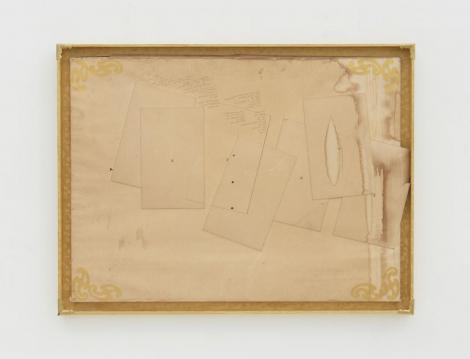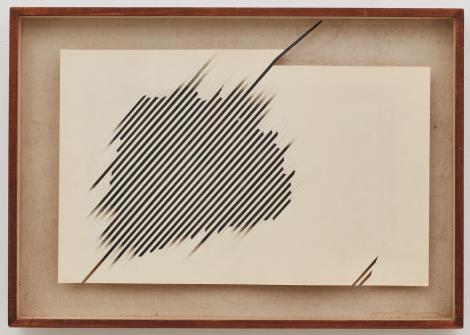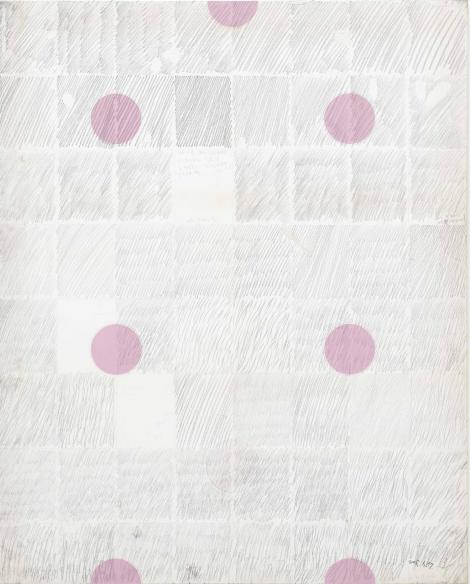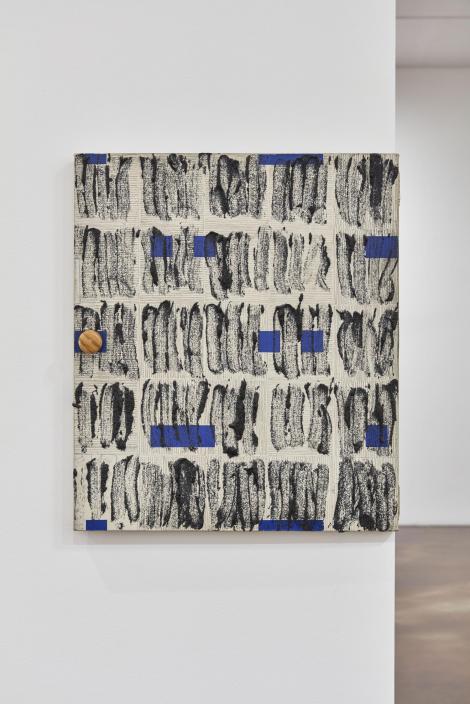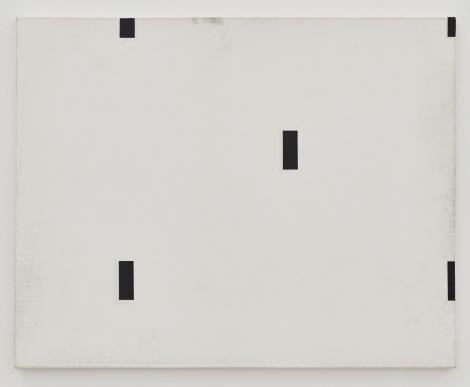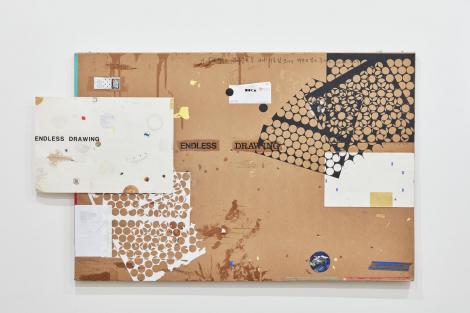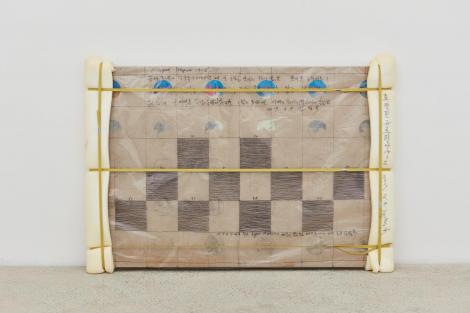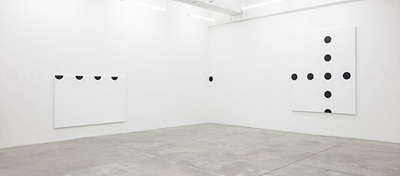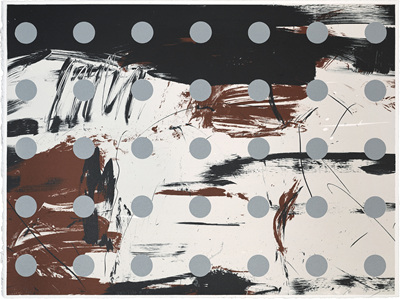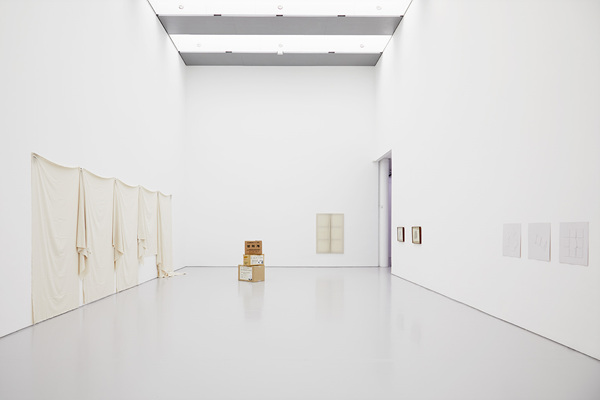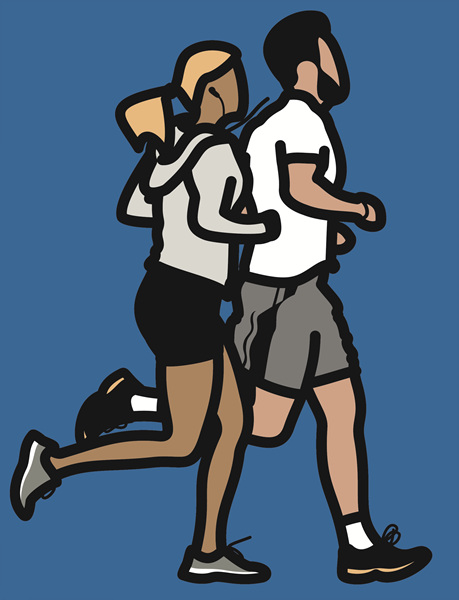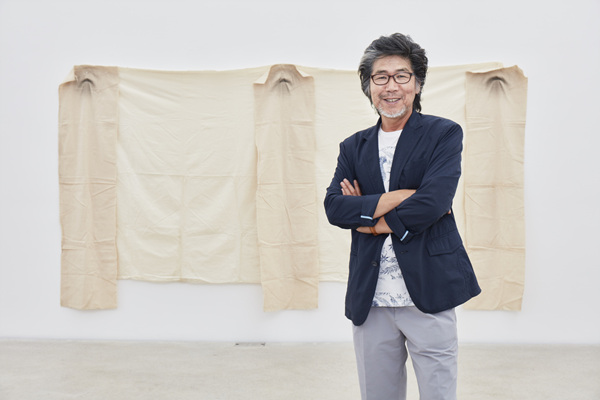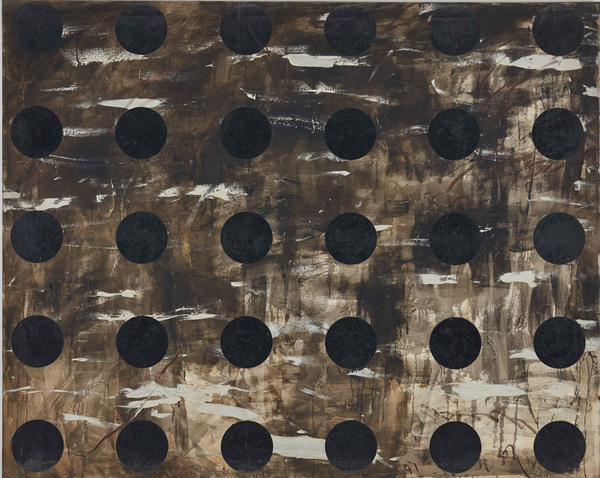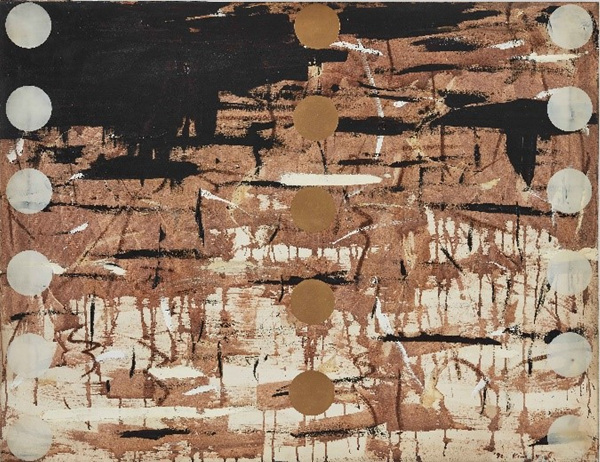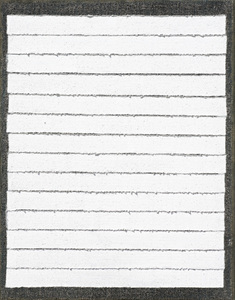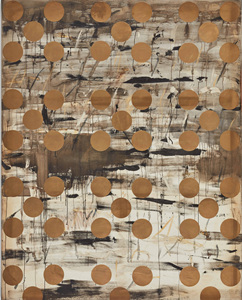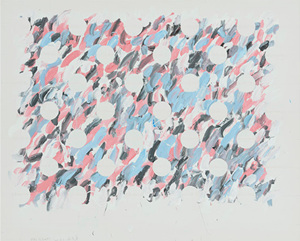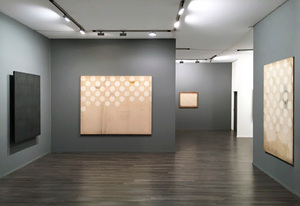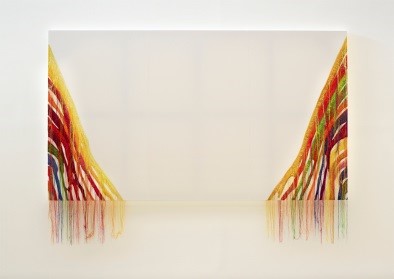 ENDLESS DRAWING | KUKJE GALLERY
ENDLESS DRAWING | KUKJE GALLERY
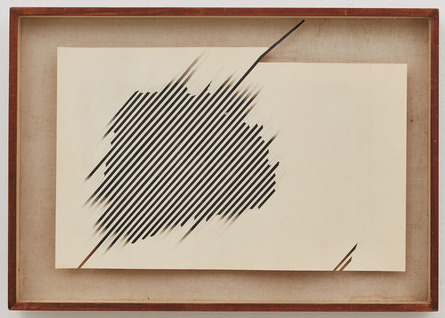
Mar 20, 2018 - Apr 22, 2018
INTRODUCTION
1. A work that employs old, tattered, and economical mediums
2. A work that does not require much extraneous effort such as manual labor or complex technique
3. A work that is continuously in progress and does not remain static in a stage of completion
4. A work that is not contingent on minor damage, dirt, and mold
5. A work that does not conceal inadvertent blunders such as a blemish or smudge
6. A work that is still in progress, perhaps in need of further production
7. A work that can easily be damaged
8. A work that wraps around, or tarnishes, an existing work
And so forth…
– Kim Yong-Ik, 2017.11.27.
Kukje Gallery is pleased to announce Endless Drawing, a solo exhibition of work by Kim Yong-Ik on view from March 20 to April 22, 2018. This is the artist’s second showing at the gallery following his first exhibition of new paintings in 2016. For Endless Drawing, Kim will show a range of approximately forty never-before-seen “drawings” that have served as the bedrock of his practice over almost forty years, dating from the 1980s to the present.
Deviating from the tradition of distinguishing between painting and drawing by medium, Kim defines a “painting” as work that is self-contained and results in a finished product whereas a "drawing" is characterized by its openness that is embracive of an ongoing process. These distinctions are based on the artist's belief that a "painting," when completed, should not allow any additional edits, whereas “drawings” can be endlessly altered over time.
Since the beginning of his practice in the 1970s, Kim Yong-Ik has made work that challenges underlying principles of modernism. He has consistently tried to upend the viewer’s expectations, undermining predominant typologies of art and their resultant cultural and economic hierarchies. The basis of this critique is Kim’s argument that artwork should be allowed to change in a process he terms “eco-anarchism,” thereby producing works that teeter between modernism and eco-anarchism. Eco-anarchism challenges the way the market preserves artwork as a fixed commodity; in response, Kim embraces entropy, the contamination of mediums over time that he cultivates through a process of intentional neglect. He also advocates for the use of old and humble materials in a bid to short-circuit the emphasis on monetary value and challenge existing cultural mores. This philosophy has remained a consistent thread throughout Kim’s long career beginning with his Plane Object series in the 1970s, followed by the geometric compositions from the 1980s, his dot paintings from the 1990s, earlier works that have been entombed in "coffins" from the 2000s, to his recent works that feature canvas works bound in packing materials and left unattended. In this way, the artist’s interest in works maintaining a status of ongoing process as drawing took on a new relevance that continues to today.
Such philosophy behind Kim Yong-Ik’s practice delays and obstructs the existing, established compositions and interpretation of his works. Not only do the mold, dirt, and scratches that accrue on the artwork bear evidence of the passing of time but they also allow for an evolving interpretation of the work. In addition, Kim continues to add new layers to his existing work by scribbling short diaristic entries onto the surface, burying old works in a wooden frame, carelessly leaving a canvas outside of his studio for the work to gather mold, or transforming a collection of drawings into an installation. This forms an asymmetric yet interesting relationship with the overarching customs of the contemporary arts scene, including the issues of preservation, conservation, archiving, packaging, transportation, and circulation. Endless Drawing showcases a diverse group of works that share the common denominator of “conceptual-drawings” that challenge the notion that drawing is limited to works on paper.
As part of his wide-ranging practice Kim has always been a writer, publishing his ideas and using language both in essay form and on his canvases. The below text embodies the artist’s philosophy, articulating his goals for the show at Kukje Gallery.
On Endless Drawing
The works on view in this exhibition, like many of my past works, alternate between the two polar opposite philosophies of modernism and eco-anarchism; but it seems that these works in particular lean toward the latter.
My definition of eco-anarchism, within the parameters of my practice, consists of acquiring and using old and tattered mediums—agents that will be tossed aside as garbage—and acts of neglecting or aggressively inducing my works to decay, or even intentionally damaging them.
I refer to such eco-anarchist works as drawings, as an alternative to the painting genre. The definition of “drawing” already connotes that the work in progress has yet to be rendered complete, but I added the word “endless” in order to make the significance more apparent.
Eco-anarchism became an engrained thought of mine during the month I was in India from December of 2009 to January of 2010. The phrase that most stuck with me, from my diary in India, is “I have already drunk the poisoned cup of capitalism.”
And so it is. Even though I dare speak of “eco-anarchism” and produce low-entropic works that minimize waste, I’m already inextricably addicted to the comforts of a life steeped in capitalism to execute my life and art according to the principles of eco-anarchism; I’ve lost all basis to argue for eco-anarchism. Therefore, it is out of self-deception that I produce and showcase these works. But I nonetheless produce and showcase these works, the sole reason for this being an act of self-consolation. It is impossible to live in this age of catastrophes without any self-consolation.
And even though the history of human beings, who live on the organic, breathing system we call planet Earth, is marching towards its end, and knowing that we must resist this cataclysm by fundamentally changing our lives by any means, my work attempts to offer paltry consolation to myself and those like me, who cannot but remain exposed to the temptations and perils of capitalism. A consolation that, by asserting eco-anarchism and sympathizing with my sentiment, could ensure that we are contributing to the delay of the impending cataclysm.
Someone may console me—perhaps by suggesting that these eco-anarchistic, low entropic works are meaningful as they incubate a seed of hope for the future. But I’d rather find consolation from the term “self-consolation,” rather than from this nebulous comment.
Perhaps someone may believe that art has the power to change society, and possibly comment on the political capacity these works bear. I once sought and found faith in that statement but now think that art, rather than follow the political, should transcend it and can only realize its full potential when it takes on the “role of consoling its audience.” However paltry it may be, this power of consolation results from the process of self-negation and acceptance of its mortality.
– Kim Yong-Ik, 2018.3.5.
Rejecting the dichotomy of painting and drawing, Kim has developed a philosophy and studio process defined by a dynamic set of vocabularies: "painting – completed form – enclosed structure – principle agent – the aesthetic of separation and elimination – modernism" and "drawing – continuous form – open structure – the other – the aesthetic of solidarity and reliance – postmodernism." These parameters allow the artist to engage critically the social and economic context of artworks thereby retaining both intellectual flexibility as well as control over the interpretation of his works. His ideas are in part inspired by the 19th century Joseon dynasty philosophy Jungyeok, which sees the cosmos as comprised of numerical principles that can be used to predict the future. Adopting this cosmological and economic viewpoint, Kim argues that the modern world has now exhausted its ability to create new art and we are now in an age where the artist acts as an editor who re-appropriates and rearranges existing artworks. For Kim, this can be understood as a paradigm shift wherein the aesthetic of drawing has replaced the aesthetic of painting, leaving the latter void of the significance it once carried.
About the Artist
Kim Yong-Ik was born in Seoul in 1947 and graduated from Hongik University in 1980 with an MFA in Painting. He served as a professor of Painting at the Arts and Design College in Gachon University (former Kyungwon University) from 1991 to 2012. In 1999, Kim co-established Art Space Pool (former Alternative Space Pool), one of the first alternative art spaces in Korea, and served as its representative member from 2004 to 2006. As an enduring critic, writer, and an artist for the past four decades, Kim has been working in various contexts spanning modernism, the Minjung art, land art, and public art, continuously questioning his practice and art. Following his successful retrospectives at Ilmin Museum of Art (2016) as well as Spike Island, Bristol and Korean Cultural Centre UK, London (2017), Kim’s oeuvre has been garnering increasing attention from the international audience. The extensive practice of Kim’s career will also be presented at Art Basel Hong Kong Kabinett sector from March 29 to 31, 2018.
Kim Yong-Ik has held solo exhibitions at numerous institutions including I Believe My Works Are Still Valid, Spike Island, Bristol, and Korean Cultural Centre UK, London (2017), Closer... Come Closer..., Ilmin Museum of Art, Seoul (2016), Timidly Resisting the No-Pain-Civilization, Art Space Pool, Seoul (2011), and Kumho Museum of Art, Seoul (1997). Selected group exhibitions include the 5th Yokohama Triennale (2014), SeMA Gold 2012: Hidden Track at Seoul Museum of Art (2012), Nature and Peace, Geumgang Nature Art Biennale (2010), After the Grid, Busan Museum of Art (former Busan Museum of Modern Art; 2002), The 1st Korean Young Artists Biennial, National Museum of Modern and Contemporary Art (1981), the 13th São Paulo Art Biennial (1975), and a series of Independants exhibitions at the National Museum of Modern and Contemporary Art from 1974 to 1979. His works are in the permanent collections of the National Museum of Modern and Contemporary Art, Korea; Busan Museum of Art; Seoul Museum of Art; Leeum, Samsung Museum of Art; Tokyo Metropolitan Art Museum; Los Angeles County Museum of Art; and The Museum of Contemporary Art, Los Angeles among many others.
내가 생각하는 드로잉 작품이란
1. 낡고 허름하고 값싼 재료를 사용한 작품
2. 별다른 노동이나 테크닉 등 공을 별로 들이지 않은 작품
3. 완성되어 고정되어있는 것이 아니라 끊임없이 진행되는 작품
4. 좀 부서지거나 더럽혀지거나 곰팡이가 나도 상관없는 작품
5. 작업 도중 발생한 의도치 않은 얼룩 등 실수를 감추지 않는 작품
6. 만들다 중간에 그쳐서 더 손을 대할 것 같은 작품
7. 손상되기 쉬운 작품
8. 기존의 작품을 지우거나 포장해버리거나 훼손시킨 작품 등등이다.
- 2017.11.27. 작가의 말
국제갤러리는 3월 20일부터 4월 22일까지 김용익의 개인전 《엔드리스 드로잉(Endless Drawing)》을 개최한다. 작가의 최신 회화 작품을 선보인 지난 2016년 국제갤러리에서의 첫 개인전에 이은 두 번째 개인전으로, 이번 전시에서는 1980년대부터 현재에 이르기까지 40여년 간 작가 작업의 근간을 이룬 다양한 드로잉 작업 40여 점을 처음으로 소개한다.
재료에 따라 회화와 드로잉을 구분하는 미술계의 관행과는 달리 김용익은 내부적으로 닫혀진 자기완결적 완성태를 ‘회화’로, 외부적으로 열린 과정적 지속태를 ‘드로잉’으로 일컫는다. 완성된 ‘회화’에는 어떠한 첨가도 용인되지 않지만, ‘드로잉’에는 지속적인 덧칠이 가능하다고 생각하기 때문이다.
김용익은 1970년대 작업 초기부터 순수미술이라는 범주 안에서 모더니즘적 관행의 지배적 특성에 균열을 내는 작업을 지속해 왔다. 예컨대 조형적인 완성태로서의 그의 작업은 문화, 경제적 가치를 부여 받는 전통적 예술 작품의 특성 혹은 태도와 교묘하게 어긋난다. ‘모더니즘과 에코 아나키즘(eco-anarchism) 사이를 오가는’ 일련의 작업군은 작품의 보존과 안치라는 기존 개념과 거리를 두며, 자의적 훼손과 방치뿐 아니라 낡고 허름한 재료의 존재를 적극적으로 수용한다. 그러므로 70년대의 평면 오브제, 80년대의 기하학적 추상, 90년대의 땡땡이 회화 그리고 2000년대 자신의 과거 작업을 ‘관’ 속에 안치시킨 관 작업과 허름한 포장재로 캔버스를 둘둘 싸맨 후 무심히 방치하는 최근작까지, 작가의 대표적 작업은 모두 ‘드로잉적’인 작업으로 해석할 수 있다.
이런 과정을 통해 김용익의 작업은 작품에 고정된 형태와 해석을 지연시키고 방해한다. 시간이 만들어낸 곰팡이나 먼지, 운송과 설치 과정에서 더해지는 흠을 작업의 일부로 받아들이고, 조형적 균형을 갖춘 모더니즘적 회화 표면에 주기적으로 글을 써넣거나, 과거 작업이 30년 후 새롭게 제작되는 작품 안에 봉인되기도 하며, 낡은 가방 속 허름한 스케치북에 담겨 있던 드로잉이 후일 설치 작업으로 전환되는 등의 흥미로운 사건이 일어나는 것이다. 이는 현 미술제도 내에서 작동하는 보존·수복, 기록·보관, 포장, 운송 그리고 유통에 이르기까지, 다양한 관행과도 불균형적이지만 흥미로운 이해관계를 형성한다.
〈엔드리스 드로잉(Endless Drawing)에 대하여〉
이번에 전시되는 작품들은 이전의 내 작품들이 그렇듯이 모더니즘과 에코 아나키즘(eco-anarchism)이라는 두 극점(極點) 사이를 오가는 작품들이되 에코 아나키즘에 조금 더 기운 모양새다.
내가 생각하는 내 작품에 있어서의 에코 아나키즘은 작품이 썩든지 말든지 그냥 내버려 두거나 적극적으로 썩게 만들거나 일부러 훼손하는 행위를 포함하여 낡고 허름한 재료들, 쓰레기로 버려질 쓰고 남은 재료들을 찾아내어 사용하는 것이다.
나는 이러한 에코 아나키즘적 작품을 페인팅의 타자로서의 드로잉이라고 부른다. 드로잉이라는 말에는 이미 완성태가 아닌 지속태라는 의미가 함축되어있지만 그 의미를 강조하기 위해 엔드리스(endless)란 형용사를 붙였다.
에코 아나키즘은 2009년 12월에서 2010년 1월에 걸쳐 인도에서 한 달 동안 지내며 확고하게 내 안에 자리잡게 된 듯하다. 그 때의 일기 중에 가장 기억에 남는 구절은 “나는 이미 자본주의의 독배를 마셨다"라는 구절이다.
그렇다. 내가 지금 에코 아나키즘을 입에 올리며 쓰레기 발생을 최소화하는 ‘저(低) 엔트로피 작업’을 하고 있지만 내가 에코 아나키즘을 내 삶과 예술로 수행하기엔 이미 나는 자본이 제공하는 삶의 안락함에 깊숙이 중독되어 있어서 에코 아나키즘을 주장할 토대를 상실하였다. 따라서 이런 작업을 하고 발표를 한다는 것은 자기 기만이다. 그럼에도 나는 이렇게 제작하고 발표한다. 그 이유는 오로지 자기위안 때문이다. 자기위안이라도 하지 않고는 이 파국의 시대를 살 수가 없기 때문이다.
그리고 지구라는 유기적 생명체 위에 살고 있는 인간의 역사가 그 마지막을 향해 달려가고 있지만, 그래서 어떻게든 우리의 삶을 근본적으로 바꾸어서 그 파국을 저지해야 함을 알면서도 자본주의의 유혹과 겁박 때문에 어쩌지 못하는 나와 동류의 사람들에게 나의 작품은 조그만 자기위안 거리를 주려는 것이다. 이렇게 에코 아나키즘을 주장함으로써, 그리고 거기에 동조 함으로써 뭔가 이 파국을 지연시키는데 일조라도 하는 게 아니겠느냐는 위안 말이다.
혹자는 이러한 에코 아나키즘적 저(低) 엔트로피 작업이 미래에 대한 희망의 씨앗을 품고 있기에 의미 있지 않냐는 말로 나를 위로해 줄 수 있을지도 모른다. 그러나 나는 막연해 보이는 그 말에서 위안을 찾기보다는 “자기위안”이란 말에서 위안을 찾으련다.
또 혹자는 예술이 사회를 바꿀 수 있는 힘을 믿으며 이러한 작업이 갖는 정치적 힘을 입에 올릴 수 있을지도 모른다. 나 역시 이 말에 힘을 더러 얻어보기도 했었으나 예술은 역시 정치적인 힘을 따르기보다는 그 힘을 벗어난 곳에서 “위로하는 역할”을 자임할 때 그 힘을 제대로 낼 수 있는 것이란 생각이 든다. 그때 그 힘의 정체는 희미한 힘이되 자기 부정을 거쳐 나온 힘이며 “죽음의 보증”을 거친 힘이리라.
- 2018.3.5. 작가의 말
김용익은 페인팅과 드로잉에 대한 이분법적인 구분에 저항한다. 이런 태도는 ‘페인팅 – 완성태 – 닫힌 구조 – 주체 – 분리와 배제의 미학 – 모더니즘’과 ‘드로잉 – 지속태 – 열린 구조 – 타자 – 연대와 의존의 미학 – 탈모더니즘’이라는 의미의 연쇄고리를 형성하며 작업에 내재된 정치적인 해석을 가능케 한다. 이를 위해 작가는 19세기 조선의 철학 사상인 정역(正易)의 우주론을 차용한다. 이제 우주는 새로운 것의 창작이 가능했던 시대를 지나 후천개벽(後天開闢)의 시대를 맞이했고, 그리하여 현 시대의 예술가는 기존의 것을 재전유 및 재배치하는 에디터로서의 역할만 한다고 읽는다. 이는 곧 페인팅의 미학이 그 의미를 상실한 채 드로잉의 미학으로 대체되는 패러다임으로서의 변화를 상징한다.
《엔드리스 드로잉(Endless Drawing)》 전은 종이라는 매체에 국한되어 있던 드로잉이라는 주체의 틀에서 벗어나 보다 자유롭고 열린 ‘드로잉적’ 개념으로 단단히 연결된 다양한 작업을 펼쳐 보인다. 이번 전시는 ‘드로잉 개념 작가’의 김용익의 에코 아나키즘적 작업의 기저에 흐르는 ‘회화의 타자로서의 드로잉’에 대한 정의를 재고하는 기회가 될 것이다.
나는 ‘거룩함’을 가난한 인간, 오래된 것, 굶주리고 병든 동물, 버려진 장소에서 찾는다.
나에게 있어 드로잉과 글쓰기는 이런 거룩한 것들에게 경배하는 방법이다.
- 작가의 말
작가 소개
김용익은 “물감 잔뜩 묻은 작업복을 걸치고 캔버스 앞에서 물감칠을 하기보다는 깨끗한 옷을 입고 책상 앞에 앉아서 컴퍼스와 자로 작도하기를 선호하는 드로잉 개념 미술가”이다. 1947년 서울에서 태어났으며 홍익대학교 미술대학 회화과에서 학사와 석사 학위를 받았다. 1991년부터 2012년까지 가천대학교(구 경원대학교) 미술디자인대학 회화과 교수를 역임하였고 1999년 대안공간 풀의 창립에 참여하였으며 2004년부터 2006년까지 대표로 재직했다. 한국의 대표적인 중견 작가로서 모더니즘 미술, 민중미술, 공공미술, 자연미술 등 다양한 맥락 속에서 작업을 전개해오며 지속적으로 문제의식을 제기하는 작업을 전개해왔다.
1974년 홍익대학교 서양화과 재학시절 천으로 제작된 <평면 오브제>시리즈를 발표하였다. 이를 통해 본격적으로 등단, 화단으로부터 많은 주목을 받았으나, 1981년 작업을 박스에 ‘매장’시켜 전시에 출품하며 모더니즘 주류에서 벗어난 독자적인 노선을 선언했다. 이후 80, 90년 민중미술과 모더니즘의 과도기적 양극화에 대한 국내 화단의 풍토를 지양하며 공공미술, 글쓰기 및 저서활동, 지역기반의 환경미술 운동 등에 적극적으로 참여하였다. 그는 미술을 둘러싼 생태와 제도, 공공의 영역에서 미술의 역할을 고민해왔다. 2016년 일민미술관 회고전, 2017년 영국 스파이크아일랜드 및 주영한국문화원 전시의 성공적인 개최를 통해 국내외 주목을 받고 있으며, 다가오는 3월 29일부터 31일까지 개최되는 아트바젤 홍콩의 캐비닛 섹터에서도 조명될 예정이다.
주요 개인전으로는 2017년 《나는 아직 나의 작품을 유효하다고 믿는다》 스파이크아일랜드 및 주영한국문화원, 2016년 《가까이... 더 가까이...》 일민 미술관, 2011년 《무통문명無痛文明에 소심하게 저항하기》 아트 스페이스 풀, 1997년 금호미술관 개인전이 있다. 주요 단체전으로는 2014년 제 5회 요코하마 트리엔날레, 2012년 《SeMA 중간허리 2012: 히든 트랙》 서울시립미술관, 2010년 《자연과 평화》 금강자연미술비엔날레, 2002년 《그리드를 넘어서》 부산시립미술관, 1981년 《제1회 청년작가전》 국립현대미술관, 1975년 제13회 상파울루 비엔날레, 1974과 77-79년에 걸쳐 참여한 《앙데빵당》 국립현대미술관 등이 있다. 경기도미술관, 금호미술관, 국립현대미술관, 대전시립미술관, 부산시립미술관, 서울시립미술관, 일민미술관, 도쿄도 미술관, 미국 로스엔젤레스 카운티 미술관(LACMA), 로스엔젤레스 현대 미술관(LAMOCA) 등 다수의 주요 기관에 작품이 소장되어 있다.
WORKS
|
1983-2012 |
Oblique Lines |
|
|
Closer… Come Closer… |
Eco Anarchism Project 1 |
|
|
Despair Completed |
Closer… Come Closer… |
|
|
Endless Drawing |
Wrapped Utopia #17-2 |
|
INSTALLATIONS
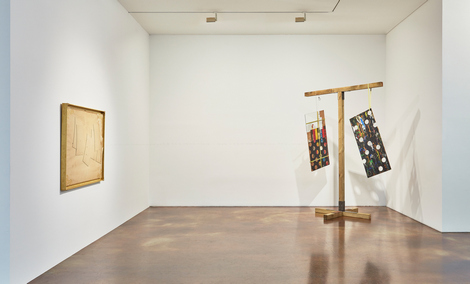
|
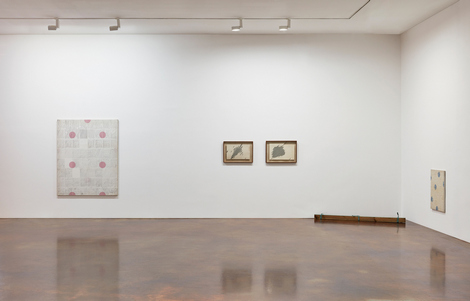
|
|
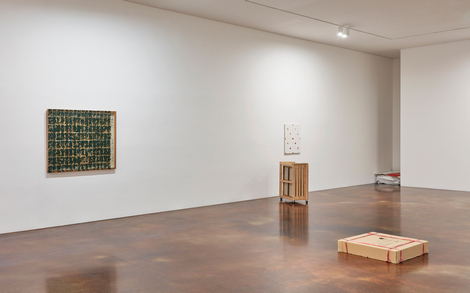
|
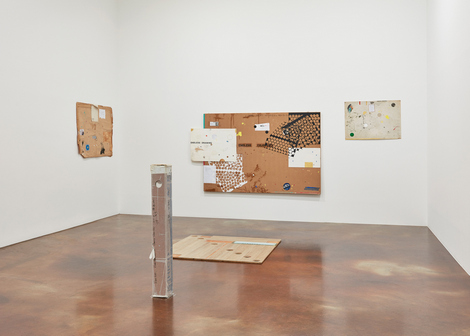
|
|
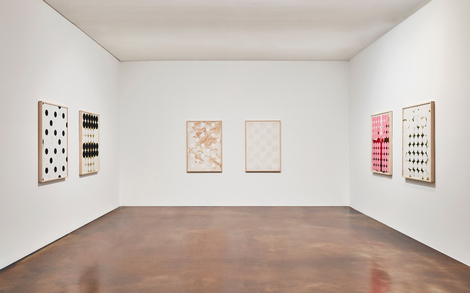
|
VIDEOS
|
Installation Video |
MEDIA COVERAGE
일간지
월간지
주간지/웹
